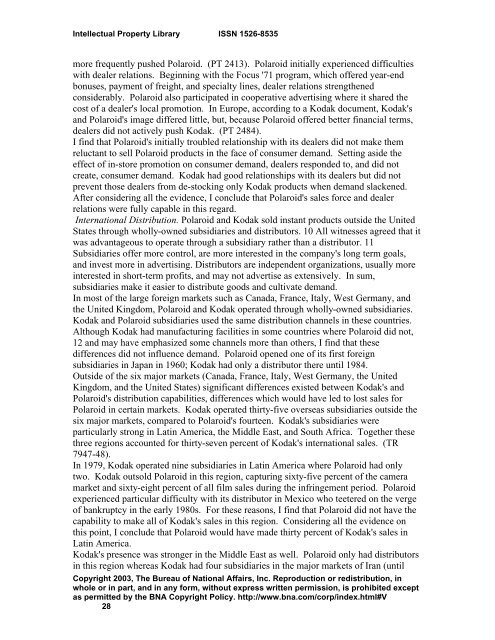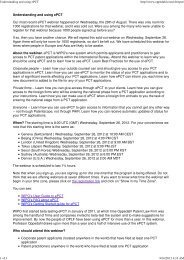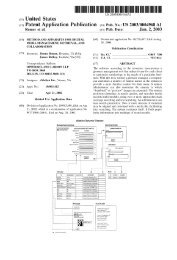Polaroid Corp. v. Eastman Kodak Co. - Oppedahl Patent Law Firm LLC
Polaroid Corp. v. Eastman Kodak Co. - Oppedahl Patent Law Firm LLC
Polaroid Corp. v. Eastman Kodak Co. - Oppedahl Patent Law Firm LLC
Create successful ePaper yourself
Turn your PDF publications into a flip-book with our unique Google optimized e-Paper software.
Intellectual Property Library ISSN 1526-8535<br />
more frequently pushed <strong>Polaroid</strong>. (PT 2413). <strong>Polaroid</strong> initially experienced difficulties<br />
with dealer relations. Beginning with the Focus '71 program, which offered year-end<br />
bonuses, payment of freight, and specialty lines, dealer relations strengthened<br />
considerably. <strong>Polaroid</strong> also participated in cooperative advertising where it shared the<br />
cost of a dealer's local promotion. In Europe, according to a <strong>Kodak</strong> document, <strong>Kodak</strong>'s<br />
and <strong>Polaroid</strong>'s image differed little, but, because <strong>Polaroid</strong> offered better financial terms,<br />
dealers did not actively push <strong>Kodak</strong>. (PT 2484).<br />
I find that <strong>Polaroid</strong>'s initially troubled relationship with its dealers did not make them<br />
reluctant to sell <strong>Polaroid</strong> products in the face of consumer demand. Setting aside the<br />
effect of in-store promotion on consumer demand, dealers responded to, and did not<br />
create, consumer demand. <strong>Kodak</strong> had good relationships with its dealers but did not<br />
prevent those dealers from de-stocking only <strong>Kodak</strong> products when demand slackened.<br />
After considering all the evidence, I conclude that <strong>Polaroid</strong>'s sales force and dealer<br />
relations were fully capable in this regard.<br />
International Distribution. <strong>Polaroid</strong> and <strong>Kodak</strong> sold instant products outside the United<br />
States through wholly-owned subsidiaries and distributors. 10 All witnesses agreed that it<br />
was advantageous to operate through a subsidiary rather than a distributor. 11<br />
Subsidiaries offer more control, are more interested in the company's long term goals,<br />
and invest more in advertising. Distributors are independent organizations, usually more<br />
interested in short-term profits, and may not advertise as extensively. In sum,<br />
subsidiaries make it easier to distribute goods and cultivate demand.<br />
In most of the large foreign markets such as Canada, France, Italy, West Germany, and<br />
the United Kingdom, <strong>Polaroid</strong> and <strong>Kodak</strong> operated through wholly-owned subsidiaries.<br />
<strong>Kodak</strong> and <strong>Polaroid</strong> subsidiaries used the same distribution channels in these countries.<br />
Although <strong>Kodak</strong> had manufacturing facilities in some countries where <strong>Polaroid</strong> did not,<br />
12 and may have emphasized some channels more than others, I find that these<br />
differences did not influence demand. <strong>Polaroid</strong> opened one of its first foreign<br />
subsidiaries in Japan in 1960; <strong>Kodak</strong> had only a distributor there until 1984.<br />
Outside of the six major markets (Canada, France, Italy, West Germany, the United<br />
Kingdom, and the United States) significant differences existed between <strong>Kodak</strong>'s and<br />
<strong>Polaroid</strong>'s distribution capabilities, differences which would have led to lost sales for<br />
<strong>Polaroid</strong> in certain markets. <strong>Kodak</strong> operated thirty-five overseas subsidiaries outside the<br />
six major markets, compared to <strong>Polaroid</strong>'s fourteen. <strong>Kodak</strong>'s subsidiaries were<br />
particularly strong in Latin America, the Middle East, and South Africa. Together these<br />
three regions accounted for thirty-seven percent of <strong>Kodak</strong>'s international sales. (TR<br />
7947-48).<br />
In 1979, <strong>Kodak</strong> operated nine subsidiaries in Latin America where <strong>Polaroid</strong> had only<br />
two. <strong>Kodak</strong> outsold <strong>Polaroid</strong> in this region, capturing sixty-five percent of the camera<br />
market and sixty-eight percent of all film sales during the infringement period. <strong>Polaroid</strong><br />
experienced particular difficulty with its distributor in Mexico who teetered on the verge<br />
of bankruptcy in the early 1980s. For these reasons, I find that <strong>Polaroid</strong> did not have the<br />
capability to make all of <strong>Kodak</strong>'s sales in this region. <strong>Co</strong>nsidering all the evidence on<br />
this point, I conclude that <strong>Polaroid</strong> would have made thirty percent of <strong>Kodak</strong>'s sales in<br />
Latin America.<br />
<strong>Kodak</strong>'s presence was stronger in the Middle East as well. <strong>Polaroid</strong> only had distributors<br />
in this region whereas <strong>Kodak</strong> had four subsidiaries in the major markets of Iran (until<br />
<strong>Co</strong>pyright 2003, The Bureau of National Affairs, Inc. Reproduction or redistribution, in<br />
whole or in part, and in any form, without express written permission, is prohibited except<br />
as permitted by the BNA <strong>Co</strong>pyright Policy. http://www.bna.com/corp/index.html#V<br />
28





